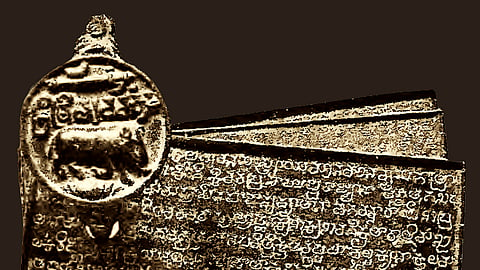- Commentary
- History Vignettes
- Notes on Culture
- Dispatches
- Podcasts
- Indian LanguagesIndian Languages
- Support

THE STUDY OF INDIAN INSCRIPTIONS is an invitation to profundity. Indian inscriptions are the concrete and lived epitomes of Dionysius’s classic dictum that history is philosophy teaching by examples. From this perspective, the un-dateable roots of Indian civilisation derive their sustenance from a spiritual philosophy that transcends time but has merely changed form when it has operated in the realm of space. Our inscriptions from the most ancient times reflect precisely this change in form.
The obsession with historical dating emanates from an Abrahamic mindset shaped by a messianic and belief-centric theology which has fixed a specific date and time for the creation of the universe. Thus, for centuries, what it regarded as history was measured from this messianic “starting point,” and what occurred before it posed an unresolvable problem because theology could not present a logical, much less a truthful, solution to it. Because theology had no solution, the pre-Abrahamic past of the world was either dismissed wholesale or rationalised as a preparatory stage. We can cite a specific example to illustrate this phenomenon. Even a prodigious scholar of history like Will Durant claims that while Buddhism was indeed a noble philosophy, it was anticipating a divine saviour like Jesus Christ! Clearly, Durant could not overcome the bias inculcated by his extensive training in Christian theology even after he became a full-fledged and professional historian in the scientific mould.
However, the intent here is not to disregard the importance of historical dating but to show its correct place (Svasthāna-parijñāna) while discussing history from a holistic perspective. In fact, in the specific area of reconstructing Indian history from the ancient period all the way down till the late medieval period, historical dating becomes especially important for two chief reasons. One, to understand this history as our own people narrated it. Two, to dispel the myths created by Western scholars of Indian history, broadly speaking. It is in these two spheres that the tools, methods, and body of knowledge required for historical dating become paramount. From an overall perspective, all these help us to accurately contextualise and reaffirm the aforementioned truth: of the philosophical roots that built and sustained our civilisation, and the values that this philosophy birthed and were upheld by our people.
EPIGRAPHY OR THE STUDY OF INSCRIPTIONS is among the most reliable tools and evidences that has proven to be invaluable in helping us understand Indian history and culture. The history of Indian epigraphy is as interesting and chequered as the history of India itself. Needless, it originated with the colonial Europeans who decided to decipher India as they understood it. Their findings were largely intended for the consumption of a cross-section of the European — primarily British — audience that included politicians, businessmen, corporates, economists, sociologists and anthropologists (who were then in a nascent stage). Both the purpose and outcome of this endeavour were political: the British used the findings of epigraphical studies to fine-tune their colonial stranglehold over India.
However, there was a non-political side to it as well, which is indeed commendable. This was the nationwide establishment of various institutions dedicated to epigraphy and allied disciplines on a massive scale.
The first attempt to study inscriptions in a systematic manner can be traced to William Jones who in 1784 founded the Asiatic Society of Bengal with the help of likeminded bureaucrats and scholars. By the 19th century, Ashoka’s inscriptions and edicts had been discovered, and in 1836, James Princep attempted to decipher them. In a way, this inaugurated the golden era of Indian epigraphy. In 1872, the periodical titled The Indian Antiquary was founded by the archeologist, James Burgess. Its full title is rather charming in hindsight: THE INDIAN ANTIQUARY: A JOURNAL OF ORIENTAL RESEARCH IN ARCHAEOLOGY, HISTORY, LITERATURE, LANGUAGE, PHILOSOPHY, RELIGION, FOLKLORE, &C, &C. Among other things, it contains an encyclopaedic repository of inscriptions along with English translations and scholarly commentaries. The Indian Antiquary soon distinguished itself as the preeminent source of European scholarship on Indian epigraphy until the late 19th century. But with the discovery of newer inscriptions at a rather rapid pace, an official journal dedicated to epigraphy was begun. This was the Epigraphia Indica, published as a quarterly supplement to The Indian Antiquary. The selfsame James Burgess edited the first volume in 1882. After 1920, it was hived off from The Indian Antiquary as an independent publication. Other epigraphic journals and reports and publications followed: Madras Epigraphical Reports (1887), South Indian Inscriptions (1890), Epigraphia Carnatica (1894), Haidarabad Archeological Series (1915), Journal of the Andhra Historical Research Society (1926), Epigraphia Indo-Moslemica (1930)… the list is quite long. Apart from the colonial British Government, the Indian Princely States too, contributed to this great Yajna of rediscovering Indian history by establishing similar institutions in their domains with Mysore as the pioneer.
Notwithstanding his numerous crimes against India, Curzon must be credited with some positives. On August 8, 1902, he invested full regnal powers upon the new Maharaja of Mysore, Krishnaraja Wodeyar IV in an elaborate coronation ceremony. Following this, Curzon visited Hampi and was awed and moved by the spectacle there. The consequence was his resolve to preserve ancient sites and monuments throughout India. Accordingly, all epigraphy and archeology departments in the Princely States came under the direct supervision of the central government. The landmark Ancient Monuments Preservation Act was passed on March 18, 1904.
To be continued
The Dharma Dispatch is now available on Telegram! For original and insightful narratives on Indian Culture and History, subscribe to us on Telegram.
